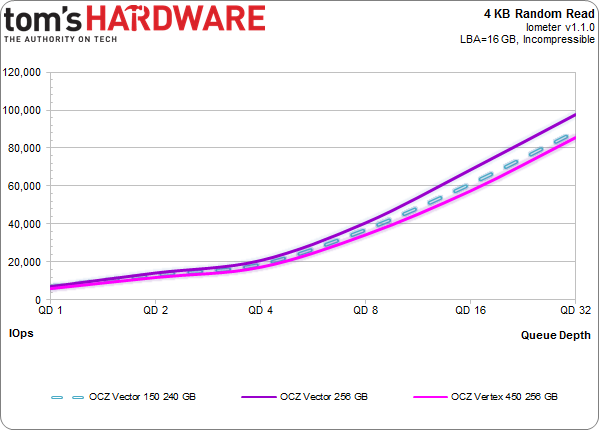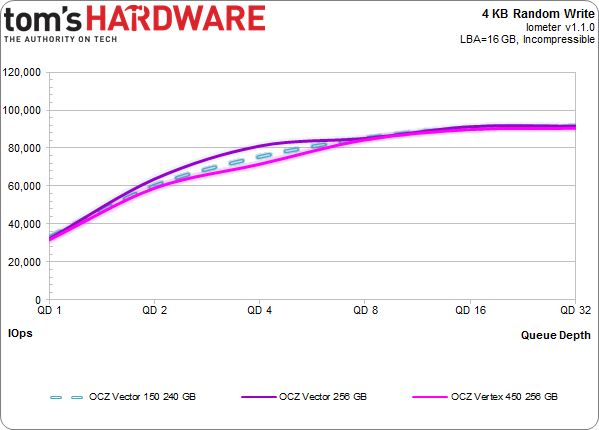OCZ Vector 150 SSD Review: A New Flagship With 19 nm Flash
OCZ is re-launching its flagship consumer SSD as the Vector 150. Armed with 19 nm Toggle-mode flash and new encryption functionality, this new drive is purported to be the pinnacle of of enthusiast-class solid-state storage. Does it live up to the hype?
Results: 4 KB Random Performance
We turn to Iometer as our synthetic metric of choice for testing 4 KB random performance. Technically, "random" translates to a consecutive access that occurs more than one sector away. On a mechanical hard disk, this can lead to significant latencies that hammer performance. Spinning media simply handles sequential accesses much better than random ones, since the heads don't have to be physically repositioned. With SSDs, the random/sequential access distinction is much less relevant. Data are put wherever the controller wants it, so the idea that the operating system sees one piece of information next to another is mostly just an illusion.
4 KB Random Reads
Testing the performance of SSDs often emphasizes 4 KB random reads, and for good reason. Most system accesses are both small and random. Moreover, read performance is arguably more important than writes when you're talking about typical client workloads.
The original Vector hits the magic 100,000 IOPS threshold. The Vertex 450 and Vector 150 can't quite get there, falling just south of 90,000. Maximum numbers are found in the chart below, but this is clearly the older Vector's ballgame. The newer Vector 150 just doesn't achieve quite the same performance level at high queue depths. Granted, at the lower queue depths most desktop tasks push, the results are fundamentally identical.
4 KB Random Writes
Random write performance is also important. Early SSDs didn't do well in this discipline, seizing up even in light workloads. Newer SSDs wield more than 100x the performance of drives from 2007, though we also recognize that there's a point of diminishing returns in desktop environments.
When you swap a hard drive out for solid-state storage, your experience improves. Load times, boot times, and system responsiveness all get better. When it's called upon, your SSD can handle a lot more I/O than the spinning media you had in there before. When it comes to typical client workloads however, getting to those operations faster is what matters, not necessarily trying to juggle more of them.
Get Tom's Hardware's best news and in-depth reviews, straight to your inbox.
In our testing, all three OCZ SSDs level off after 90,000 IOPS. But performance at lower queue depths is, again, excellent.
Here's a break-down of the maximum observed 4 KB sequential read and write performance with Iometer. The order the drives appear in our chart is determined by maximum combined read and write performance.
In retrospect, the original Vector doesn't get enough credit for its speed. It achieves a first-place finish, edging out the powerful 840 Pro. OCZ's Vector 150 slots in a couple of spots lower, while Vertex 450 falls in a few spots below that. This is a trend you'll see again before this review is over. In essence, the Vector 150 falls in between the original Vector and older Vertex 450.
Current page: Results: 4 KB Random Performance
Prev Page Results: 128 KB Sequential Performance Next Page Results: The Vector 150's Performance Quirks-
jimmysmitty Reply11918040 said:time to upgrade from vertex 4 to 150
I just hope the quality increased. Only because at my last job we had used Vertex 3s for all of our work stations and they one by one started having random issues, from not being detected to wiping the partitions.
I like OCZ because they help lower the price of SSDs but there has to be quality behind the price as well. -
Sakkura Some of the numbers in the bottom diagram on page 4 seem to be off. Look at the Intel 520 180GB for example; the random write bar is longer than the random read bar, but the actual IOPS numbers are the other way around.Reply -
Sakkura Reply
My impression is that OCZ was hit hard by the Sandforce issues, partially as a result of being an early adopter. Their newer drives seem to be reliable.11918340 said:11918040 said:time to upgrade from vertex 4 to 150
I just hope the quality increased. Only because at my last job we had used Vertex 3s for all of our work stations and they one by one started having random issues, from not being detected to wiping the partitions.
I like OCZ because they help lower the price of SSDs but there has to be quality behind the price as well. -
cryan Reply11918441 said:Some of the numbers in the bottom diagram on page 4 seem to be off. Look at the Intel 520 180GB for example; the random write bar is longer than the random read bar, but the actual IOPS numbers are the other way around.
Awesome catch! The 520 seems to have the right bar length, but the label from the Intel 510. I'll sort that out, but that's a genuine not-my-fault problem. One of the very few. I can blame Excel 2013 with confidence, but kudos for the eagle eye.
The random write bar is correct though; the SandForce-based 520, 525, and Intel 530 each pull down more random write IOps than read with incompressible data.
Regards,
CR -
Amdlova I got two SSD vertex 4 128gb on my computer 3770k and on my girlfriend 3470 I never get an single error on this SSD. raid 0 or normal configs. run solid!Reply -
ssdpro Reply11918455 said:My impression is that OCZ was hit hard by the Sandforce issues, partially as a result of being an early adopter. Their newer drives seem to be reliable.
Early on yes, but the 2nd gen SF drives really are pretty darn stable now. OCZ has had solid top tier releases since the Vertex 4. I own Vertex 4 and Vector, will probably get a 150. Hands down the worst thing they ever did was try budget/value offerings like the Petrol. I don't think there is any reason for fanboism, I own Samsung and OCZ drives and all work happily together.


